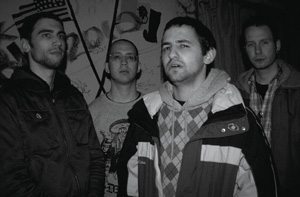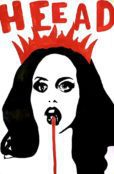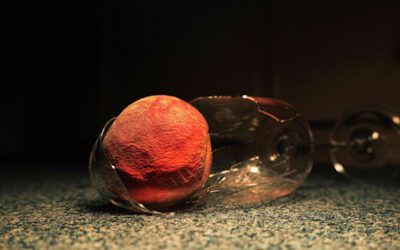[dropcap style=”font-size:100px; color:#992211;”]A[/dropcap]nger, aggression, angst. Worthless is pure hardcore, so does it matter that it sounds so familiar?
For metal/hardcore bands, the transition from live to studio is always challenging. Channelling such a huge volume of sound, and sound intensity into a recording takes some of the most meticulous sound engineering, whilst the recording takes place, and then mixing and mastering afterwards.
Very few hardcore bands ever really feel the energy of their live performance is conveyed by their records, the most-cited phrase in the press releases which come with the genre are variations of ‘the record sounds heavy, but the live show is far heavier’. On stage, you can turn amplifiers up to maximum and be reassured that the simple physics of moving air with soundwaves will flood a room with the combination of loudness and dynamic range that overwhelms the audience. When your music is based around the conveyance of aggressive emotion and drama, it works.
…the record sounds heavy, but the live show is FAR heavier…
In the studio, things are different. Unless you have access to vast and acoustically perfect studio space, it’s down to your sound engineer. There are tricks, and emulation software that does a reasonable job of sounding like amps on stage, but it’s limited. Those limits are not so significant on a well-mastered CD , but on a 320kbps mp3 file, played at volume, they pull the depth out of the record. The standard reaction to this is to compensate with loudness. 
The side-effect of manipulating soundwaves to carry more energy is that the contrast between peaks and troughs in those waves is minimised. If we imagine soundwaves as spherical instead of linear (which they are, sound travels three-dimensionally), the concept is easier to grasp.
Every sound is like a wrinkled balloon – the wrinkles being the oscillations that give the sound its unique character or timbre. A violin playing a note sounds different from a singer making the same note – it’s the ripples in the soundwaves that apply that timbre to the ear. A studio can only record at a given intensity. Imagine that maximum as a box, into which the extreme outsides of the crinkled balloon fit snugly. The peaks of the soundwaves touch the sides of the box. Adding energy to our crinkled balloon soundwave simply presses the balloon harder against the walls of its box, at its most extreme point, turning the balloon square and smooth. All timbre and sound quality is sacrificed to the creation of a soundwave that contains more energy, has a more intense sound, and feels louder to the listener – but which has lost it’s unique profile of peaks and troughs.
Every sound is like a wrinkled balloon – the wrinkles being the oscillations that give the sound its unique character or timbre.
The upshot though, is that without the best engineers, studios and equipment to hand, it is incredibly difficult to record hardcore/metal and reproduce the depth and intricacy that it needs. Worthless is well-recorded for the genre, but even through a set of high-end Genelec speakers (which should be more than adequate for review purposes) the sound failed to fill the room. Whilst broad, there were empty spaces in the panorama which should have been pulsing with the energy that typifies the genre.
It is a pity, because bands like this will have listeners who will wonder why they sound weaker on the record than they do live. Listeners who continue to believe the myth that software and bedroom recording studios have made records so cheap to produce that bands should be able to get by on the proceeds of gigs and merchandise alone. Unfortunately though, this stuff really costs money to record. It may seem like hair-splitting to people whose experience of music is mainly through cheap earbuds and low bitrate mp3 files, but these technical minutiae are often the difference between the record which is mildly interesting, and the record which simply blows you away.
If the aim is to convey anger, angst, rage, aggression, malaise and frustration, this is the way to do it.
Engineering concerns aside, Worthless is almost endearing in its simplicity. If the aim is to convey anger, angst, rage, aggression, malaise and frustration, this is the way to do it.
Drums are mercilessly worked over in chunky variations of d-beat; guitars downtuned for that extra grunt and vocals are yelled with a convincing ferocity. It’s hardcore at its most minimal. As is often the case, simple things are deceptively difficult to achieve. The powerchords align perfectly with the drumfills on tracks such as ‘Obituary’ and ‘Frostbitten’, and the tightness of their playing is spot-on. What’s missing, is any sort of derivation from lead guitar riffs following what is a prodigiously skilled, but technically unchallenged drummer. Or, to put it another way, where’s the shred? Hardcore delights in stripping away the pretentious middle-eight (or sixteen) solos of traditional metal, but that’s not to say that there shouldn’t be dexterity in there either. For the most part, Worthless chunders through with tightly controlled power riffs, but misses out on the movement that some lead guitar licks would bring to the record. Even some simple dissonant pickwork would bring some psychological drama for the ear to hook onto, and turn it into a sharper assault than the blunt instrument that it is. It’s a question of ethos though – as vocalist Snyder told Where It Ends blog last July: ‘I don’t identify with the metal scene at all’
Hardcore delights in stripping away the pretentious middle-eight (or sixteen) solos of traditional metal, but that’s not to say that there shouldn’t be dexterity in there either.
That’s not to say that the record is simply a trudge through various tempo combinations of sludgy powerchord riffs, followed by a blastbeat speed section at about forty seconds, building to a quick stanza of gutteral vocals. Most of it is that, and will doubtless please fans, but it is in the moments where the album deviates from the short, sub two-minute songs that it is most interesting. Fan reaction to the two longer songs (‘Worthless’ and ‘Future’) was lukewarm, prompting bassist Drew Brown to comment: ‘I figured the feedback would piss people off’. Whether it does or not is irrelevant, Worthless is one of the highlights of the album – a building, pulsing symphonetta of harmonic manipulation that swells for four minutes and brings that dramatic complexity that is so sorely lacking on the rest of the record. Its confidence is exemplary. Feedback is also used nicely on ‘The Meeting’, a nicely symmetrical revision of song structure that typifies the band’s approach – never settling for verse-chorus-verse, although sometimes the predominance of tempo changes at around the forty-second mark seems an equally restrictive format.
Worthless is one of the highlights of the album – a building, pulsing symphonetta of harmonic manipulation that swells for four minutes and brings that dramatic complexity that is so sorely lacking on the rest of the record. Its confidence is exemplary.
Most likely, the target audience for this record weren’t born for the heyday of Korn or Coal Chamber, much less Black Flag or Discharge, so the overwhelming sense of having heard the record already won’t be relevant. For a pure, cathartic statement of hardcore anger, it is spot-on, but get it on CD, not download.
Worthless by Weekend Nachos is available from 17th May 2011 via Relapse Records

An observer first and foremost, Sean Keenan takes what he sees and forges words from the pictures. Media, critique, exuberant analysis and occasional remorse.




















